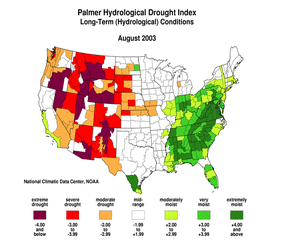|
Use these links to access detailed analyses of Global and U.S. data.


|
Damage due to the drought has been summarized by NOAA and the Office of Global Programs in the Climatological Impacts section of the Climate Information Project. Crop impact information can be found at the USDA NASS (National Agricultural Statistics Service) and Weekly Weather and Crop Bulletin pages. Drought statements by local National Weather Service Offices can be found at the NWS Hydrologic Information Center. Drought threat assessments and other information can be found at NOAA's Drought Information Center. Additional drought information can be found at the National Drought Mitigation Center, the USDA's National Agricultural Library, the interim National Drought Council, and the NOAA Paleoclimatology Program. The following states have set up web pages detailing current drought conditions and/or their plans to handle drought emergencies:
For additional information on current and past wildfire seasons please see the National Interagency Fire Center web site or the U.S. Forest Service Fire and Aviation web site. NCDC's Drought Recovery Page shows the precipitation required to end or ameliorate droughts and the probability of receiving the required precipitation. Additional climate monitoring graphics can be found at the Climate Prediction Center's monitoring pages:
Precipitation and modeled soil moisture anomaly maps for the Midwest U.S. can be found at the Midwest Regional Climate Center's monitoring page. Drought conditions on the Canadian prairies can be found at the Agriculture and Agri-Food Canada Drought Watch page. |

 For all climate questions other than questions concerning this report, please contact the National Climatic Data Center's Climate Services Division:
For all climate questions other than questions concerning this report, please contact the National Climatic Data Center's Climate Services Division:
Climate Services DivisionFor further information on the historical climate perspective presented in this report, contact:
NOAA/National Climatic Data Center
151 Patton Avenue
Asheville, NC 28801-5001
fax: 828-271-4876
phone: 828-271-4800
email: ncdc.info@noaa.gov
Richard Heim-or-
NOAA/National Climatic Data Center
151 Patton Avenue
Asheville, NC 28801-5001
fax: 828-271-4328
email: Richard.Heim@noaa.gov
Jay Lawrimore
NOAA/National Climatic Data Center
151 Patton Avenue
Asheville, NC 28801-5001
fax: 828-271-4328
email: Jay.Lawrimore@noaa.gov

 NCDC / Climate Mon. / Climate-2003 / August / U.S. Drought / Regional / Search / Help
NCDC / Climate Mon. / Climate-2003 / August / U.S. Drought / Regional / Search / Help
Downloaded Saturday, 04-Oct-2008 10:32:24 EDT
Last Updated Friday, 18-Nov-2005 14:11:44 EST by Richard.Heim@noaa.gov
Please see the NCDC Contact Page if you have questions or comments.






